One day I was sitting at my campsite, looking at all the Recreational Vehicles (RVs) and doing some quick math in my head, trying to figure out how much money in RVs was surrounding me. It was a lot. I know this doesn’t sound like an exciting way to spend my camping time, but the nerd part of my brain couldn’t resist. It got me thinking: How popular is RVing in the United States compared to other forms of entertainment and travel?
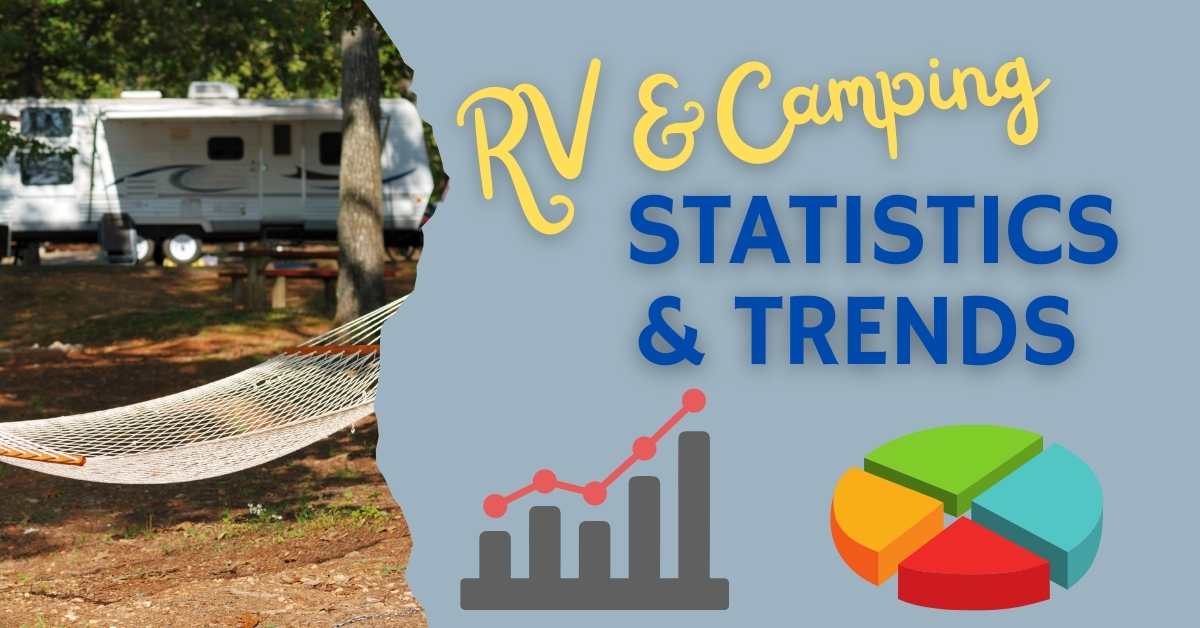
There’s no question that the RV lifestyle is popular, but what does that look like in numbers? I decided to look at all RV and camping industry segments, including RV sales and supplies, campgrounds, campers, and industry growth. So let’s take a closer look at the data:
Feel free to use or reference any of the information on this page for news articles, research, or other needs. I simply ask that you please include a reference to this page or www.outdoormiles.com when you use it.
Where does the data come from?
Camping and RVing are major parts of the US economy. As a result, it receives a considerable amount of research related to current trends, economic impacts, and projections for the future. In recent years, largely due to the Covid-19 pandemic, interest in camping and RVs surged, attracting many new people to the lifestyle.
The following data is derived from several reports and data collection efforts spearheaded by industry leaders, including the Recreational Vehicle Industry Association (RVIA) and Kampgrounds of America (KOA). The RVIA conducts regular studies of the RV industry, providing key data to RV manufacturers and RV-related businesses. KOA, a leader in the campground market, publishes an annual report of survey data assessing the camping community’s demographics, interests, and trends.
Together, these two entities provide a detailed look into the industry and valuable information that businesses, government agencies, and the camping community can use to make decisions. The research captures a clear picture of the industry, including historical changes, current conditions, and future trends.
RV Sales and the Economy
The RV industry is a powerhouse in the US economy combining RV retail sales, services, and ancillary businesses related to RV travel. Let’s take a look at some of the key statistics:
The majority of the following data comes from the RV Industry Association: RVs Move America Economic Impact Study, completed in 2019. With the surge in the RV industry beginning in 2020 and continuing through today, these numbers will likely increase in a subsequent report. However, this is the latest and most comprehensive data available today that looks at the economic impact of the RV and camping industry.
What’s the total contribution of the RV Industry to the US economy?
The RV industry is big business. However, when we consider the overall economic impact of RVing in the US, we need to look beyond RV manufacturers and RV dealerships. RVing and camping are significant elements of the travel and leisure markets, constituting RV parks and accommodations, RV parts and accessories, and traditional tourism businesses like restaurants, entertainment, outdoor activities, and service providers. RVing has become much more popular in recent years, with RV ownership at an all-time high. In 2021, RV manufacturers shipped more RVs than at any time in history. These numbers were down slightly in 2022 but still historically high. Below are some key statistics on RVing and the US economy.
- $52 Billion into local businesses in 2022
- In 2022, the RV industry contributed $140 Billion to the US economy. An increase of 23% from 2019. The breakdown of contributions is as follows:
- RV Manufacturers and Suppliers: $73.7 Billion (8% increase from 2019)
- RV Sales and Services: $30.5 Billion (34% increase from 2019)
- RV Campgrounds and Travel: $35.7 Billion (39% increase from 2019)
- The US RV Industry is responsible for creating 680,000 jobs, providing over $48 Billion in wages in 2022 (84,000 new jobs since 2019).
- There are 30,363 individual RV-related businesses in the US.
- Over 98% of all RVs sold in the US are manufactured in the US. For comparison, roughly 35% of cars sold in the US are imported (financeonline)
- The RV industry generated over $13.6 Billion in total taxes paid in 2022.
- Outdoor Recreation, which includes camping, makes up 1.9% ($454 Billion) of U.S. Gross Domestic Product in 2021.
- Campers injected $52 Billion into the local economies they visited in 2022.
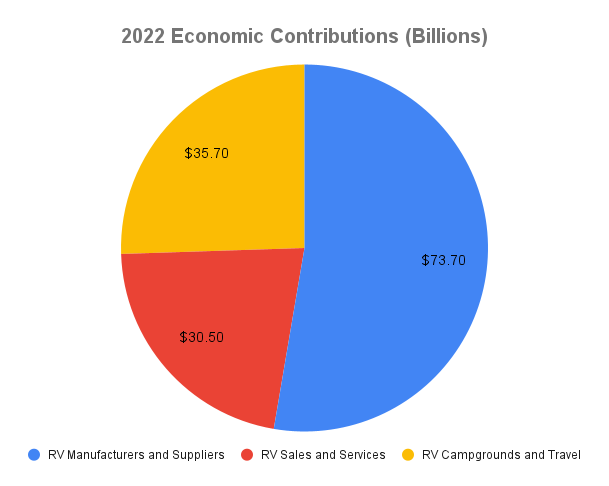
RV Sales and Growth
Data for the following sections were acquired from RVIA
- In 2021, RV manufacturers shipped a record-breaking 600,240 RVs, which included 90.64% towable RVs (travel trailers and fifth wheels) and 9.36% motorized RVs (motorhomes, camper vans, etc.)
- RV sales in 2022 were lower than the record high in 2021 but still stronger than 2019 and 2020.
- Since the 1980s, the percentage of towable RVs shipped has seen year-after-year growth compared to the percentage of motorized RVs shipped.
- Travel Trailers are the most popular type of RV.
- Motorized RV shipments, as compared to the percentage of towable RV, have been in decline since 1984. The popularity of towable RVs is growing, as evidenced by their percentage of the market share.
- RV shipments in 2023 are expected to shrink by 21%, with a likely year-end total of 379,200 to 403,600 units shipped, likely resulting from interest rate hikes, a possible recession, and record-high shipments in previous years.
- RV sales have been growing steadily since 1980, with significant growth year over year since 2009.
- The last major dip in RV shipments occurred in 2009, the RV season following the last major U.S. recession.
- RV Sales experienced their greatest gains in 2021 (39%), largely attributed to increased interest in travel alternatives due to the Covid-19 pandemic.
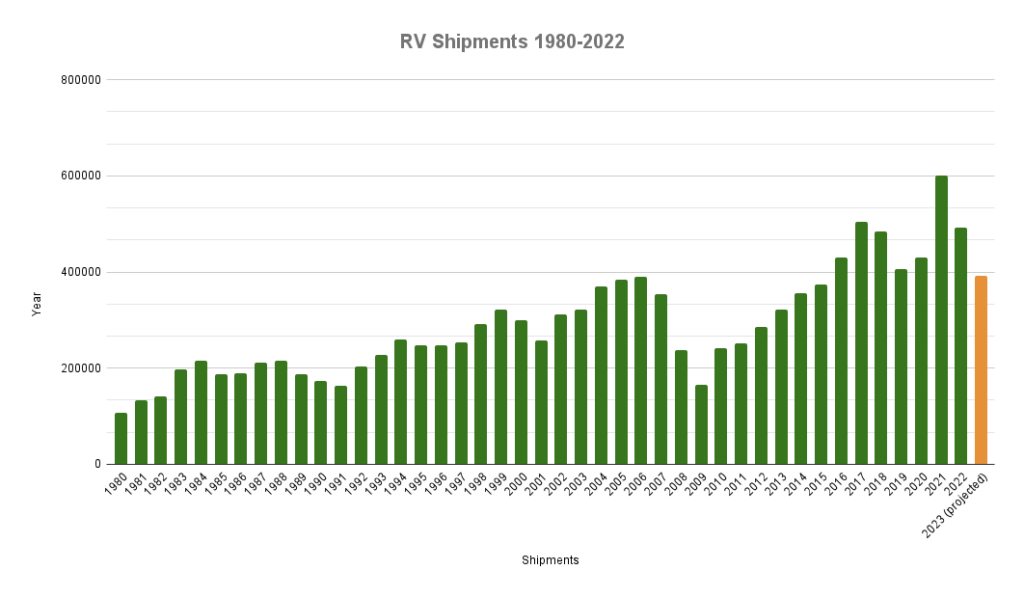
Camping community
The camping community is no longer comprised of senior citizens and baby boomers. Instead, the fastest-growing segment of new campers is Gen Zers and Millenials. Since the start of the Covid-19 pandemic, more people than ever have been hitting the open road to head out on camping and RV vacations. As in previous years, this trend is only increasing. Camping is diversifying in age groups as well as people of color, which is a great thing for the RV and camping industries. Younger generations are quickly getting into camping faster than previous generations, with a newfound goal of wanting to experience camping and RV life.
Camping has become a little different in recent years, with the advent of new camping accommodation models like Harvest Hosts, Hip Camp, and other non-traditional camping businesses offering unique accommodations. Campers also have new tools to define how they camp, thanks to the advent of peer-to-peer RV rentals, glamping, yurts, etc.
Additionally, people are exploring camping as a way of life compared to just a weekend getaway. With the increase in remote working and maybe even higher costs of living, more individuals are becoming full-time RVers.
To understand the trends of campers, let’s look at some stats. The following data is largely derived from the KOA 2022 North American Camping Report and the KOA January 2022 Camping Year In Review. Based on surveys from North Americans (US and Canada), this report highlights the current conditions and trends in the camping industry.
- In 2022, about 30% of campers were from the cohort that started camping in 2020 and 2021, during the peak of covid-driving camping trips. It’s a signal that many first-time campers continued the lifestyle when other options for travel were available.
- 74% of campers from 2022 plan to continue camping in 2023.
- The average camping trip averages were very similar to the previous year, suggesting that camping remained strong two years after the Covid-19 surge.
- In 2021, more than 59.9 million North American households camped in the U.S. This includes 9.1 million first-time camping households.
- 64% of campers reported that they camped more in 2022 or replaced other types of trips with camping.
- In 2021, nearly 94 million North American households considered themselves active campers. This is an increase of 9% over 2020.
- Camping accounted for 40% of all leisure trips taken in 2021, with more than half of travelers (53%) including camping in some or all of their travel.
- There was a 36% increase in camping trips between 2019 (pre-covid) and 2021 taken by camping households.
- 25 million Americans RV each Year
- In 2021, 77% of RVers camped with an RV they owned. This is an increase from 2019 (62%).
- There were 4.4 million more households who owned an RV in 2021 than there were in 2019.
- 23% of all new campers are RV campers.
- 47% of campers have expressed that they want to try full-time RV living.
- Millennial campers are driving the trend in RVing as a work/travel lifestyle. In 2021, 57% of millennials worked while camping.
- 60% of campers say they go camping to improve their mental health.
- Diversity in camping is improving. In 2021, 54% of new campers were non-white campers.
- The demographic data of the typical RV owner is changing: In 2019, 85% of RV owners identified themselves as white. In 2020, that number dropped to 76%. (Go RVing RV Consumer Demographic Profile)
- Camping is predicted to continue growing in 2022. The latest projection estimates that there will be 61.3 million camping households in 2022 compared to 59.9 million in 2021.
- The average RV owner is 8 years old, married, and has an above-average annual household income of $62,000.
- Former RVers are quickly being outpaced by young people looking to enter the RV lifestyle.
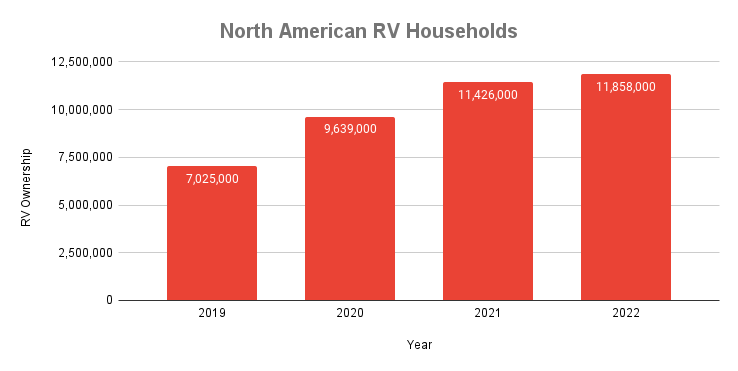
New Campers
- In 2019, only 4% of camping households were new campers. In 2020, that number surged to 21%. The trend continued in 2021, with 16% of camping trips by new camping households. 2022 rates are slowing but still above average.
- Households trying camping for the first time because of Covid-19 calmed a bit in 2021 (8%). It was 16% in 2020.
- A new trend, urban residents, are one of the most avid camping segments – 44% of this group plan to replace a leisure trip with a camping trip in 2022.
- In 2021, 40% of all campers replaced traditional leisure tips with a camping trip, largely because it was viewed as a safer form of travel due to Covid-19. In 2022, that number slowed to 32%, but still historically high.
- Over 75% of new campers who tried camping for the first time in 2021 plan to continue camping in 2022.
- 56% of non-camping households have indicated an interest in camping.
- RVing is at an all-time high, with over 15 million households RV camping in 2022.
- In 2021, 54% of new campers who had at least one camping experience came from non-white groups.
Campgrounds
Campgrounds are the backbone of the RV and camping industry. Without adequate places to camp and places to visit, the other industry segments would cease to exist. There are over 27,000 public and private campgrounds in the US and more than 2 million individual campsites. However, demand during peak camping season is inching closer to capacity. If the growth in the interest in camping continues, new facilities will need to come online to accommodate the number of campers. In addition, campground reservations are increasingly difficult to book during peak camping season, especially in popular destinations like National Parks.
RVIA Campground Industry Market Analysis (2022)
- In 2019, only 4% of camping households were new campers. In 2020, that number surged to 21%. The trend There are more camping households than ever. Camping trips made by households have increased from 68.5 million in 2014 to 105.6 million in 2021.
- Assuming the campground supply was at capacity today, based on camper trends, campground supply would need to grow by 7% each year to keep pace with current demand growth.
- The majority of campers prefer tent camping. In 2021, 64% of campers indicated tents as their preferred camping style.
- While camping occurs in many different settings, 66% of campers prefer staying in a traditional private campground, National Park, or State Park.
- Campground supply is nearing full capacity during peak camping season (June, July, and August) (76% in 2020). This data would indicate that if the campground supply is presently at capacity, supply would need to increase at a rate of seven percent per year to keep pace with current levels of demand growth.
- There are 12,290 private campgrounds and 15,119 public campgrounds in the United States.
- Most private campgrounds are located in the South. Most public campgrounds are located in the west.
- The Northeast has the least amount of camping options. The Northeast, which is more populated than other parts of the county, contains only 12% of the private campground and 4% of the public campground inventory.
- The majority of campsites (71%) are located in private campgrounds.
- 99% of private campgrounds support RV camping. 55% of public campgrounds support RV camping.
- 61% of public campsites and 63% of private campsites have RV hookups available
- 80% of State Park campgrounds offer RV sites. 52% of Federal campgrounds offer RV sites.
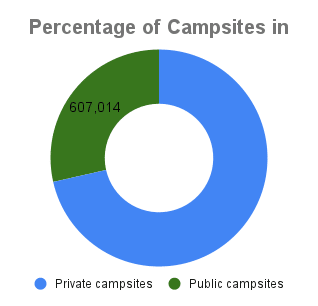
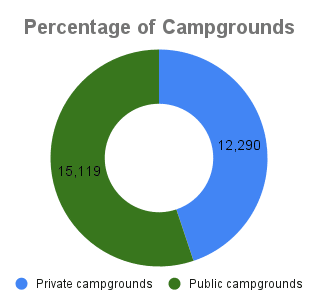
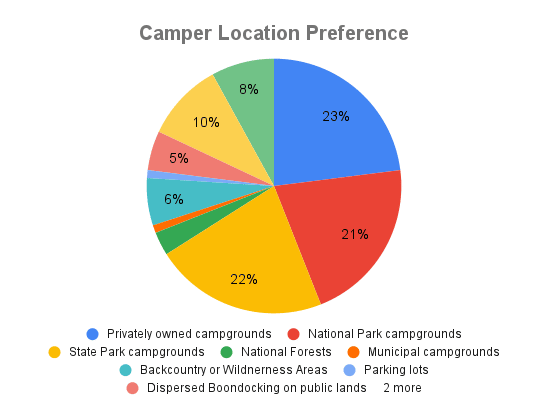
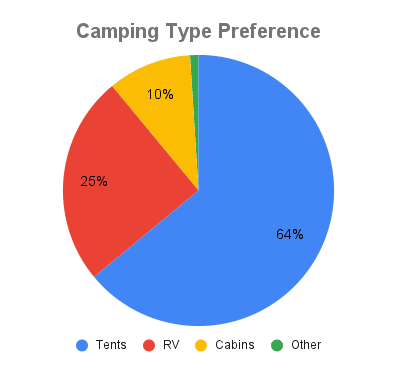
Other Statistics
- Compared to automobile accidents, RV accidents are pretty rare. However, about 70,000-80,000 accidents involving RVs occur each year.
- In 2021, used RV sales followed the automobile trend of record-high prices resulting from high demand and a short supply of new RVs.
- The best available estimates suggest that about 1 million Americans RV full-time.
- The Typical RV traveler is on the road for three weeks each year
- High gas prices will impact travel for 75% of RV owners in 2022 (Outdoormiles.com Survey Data)
